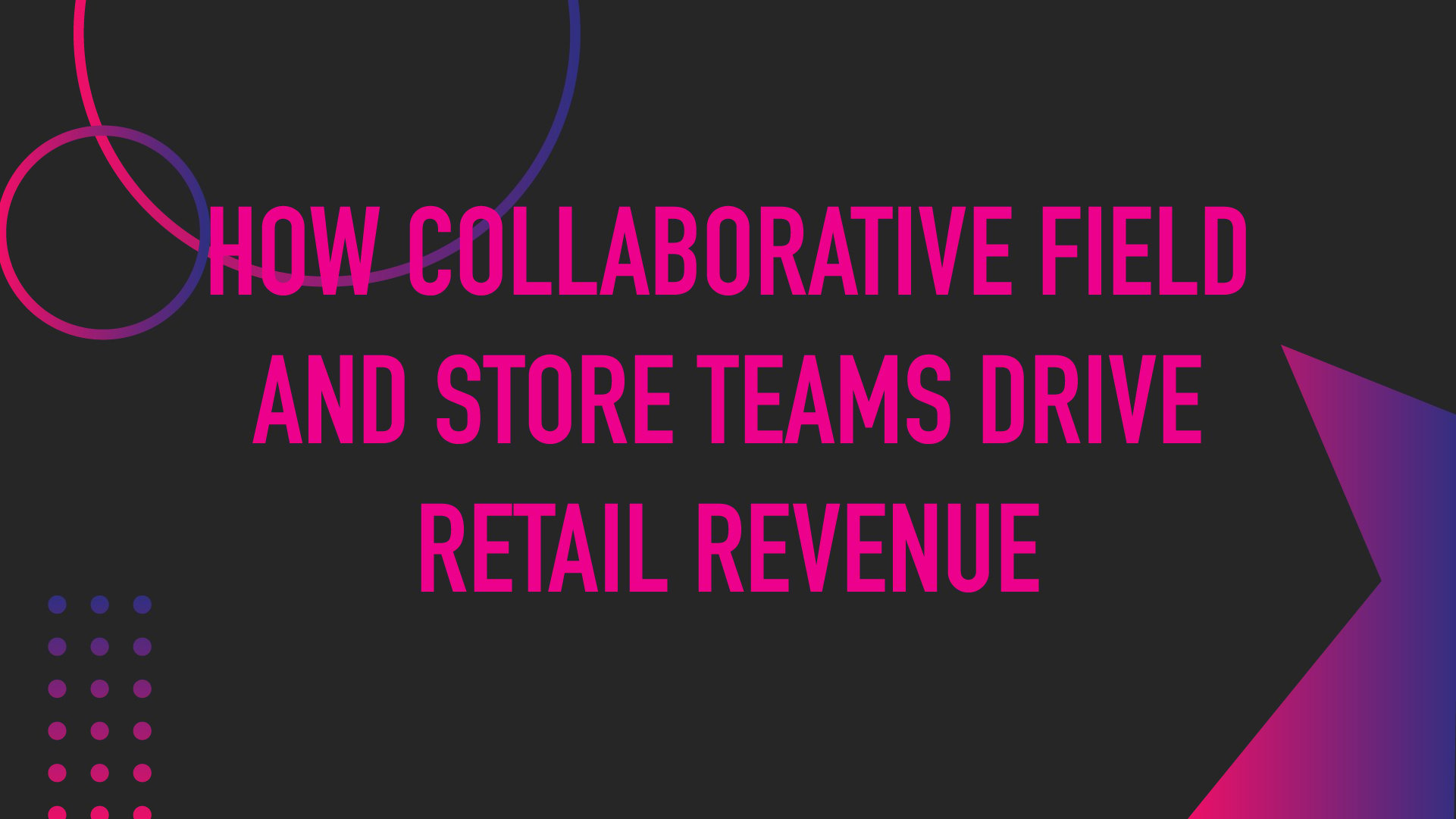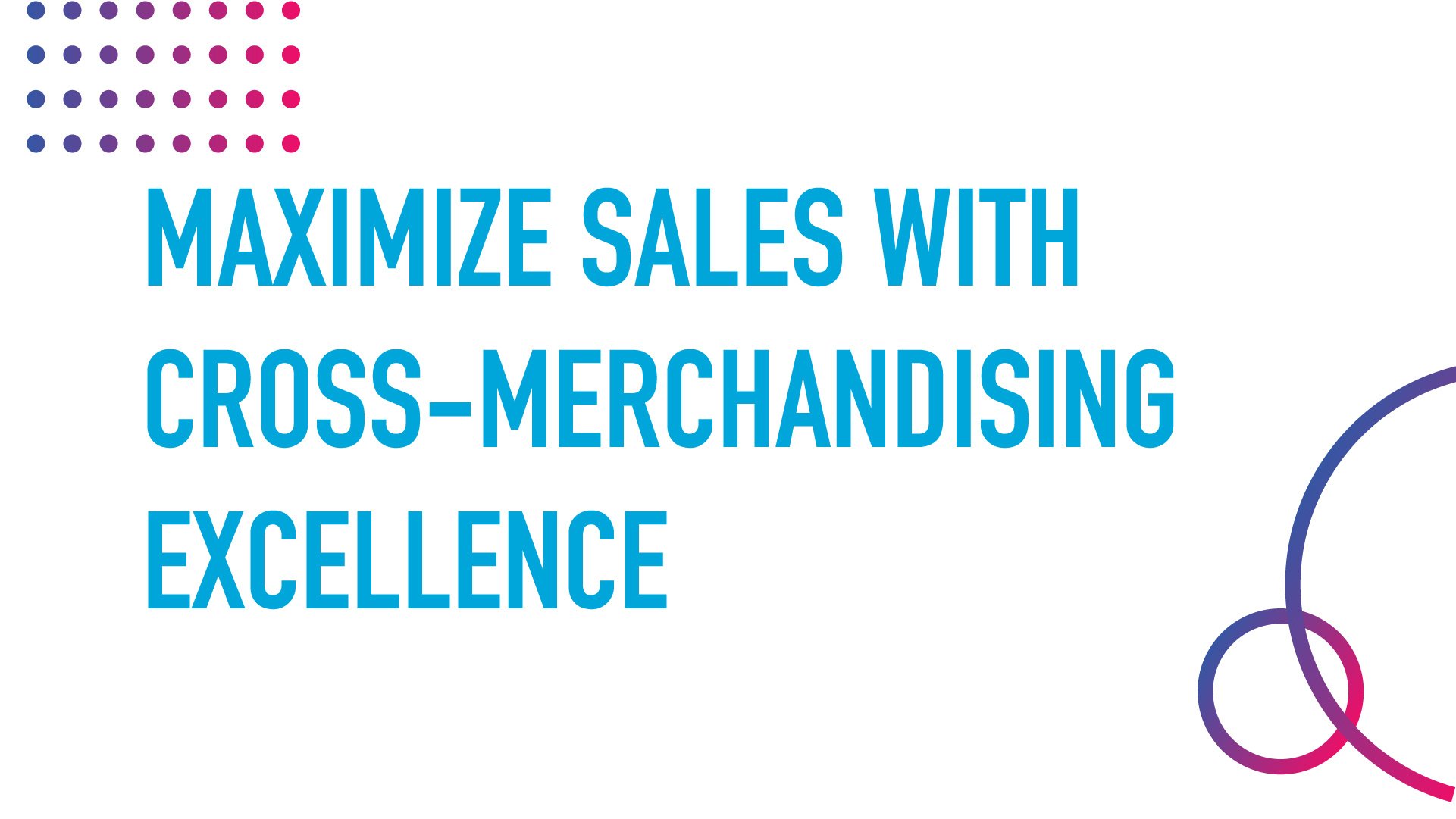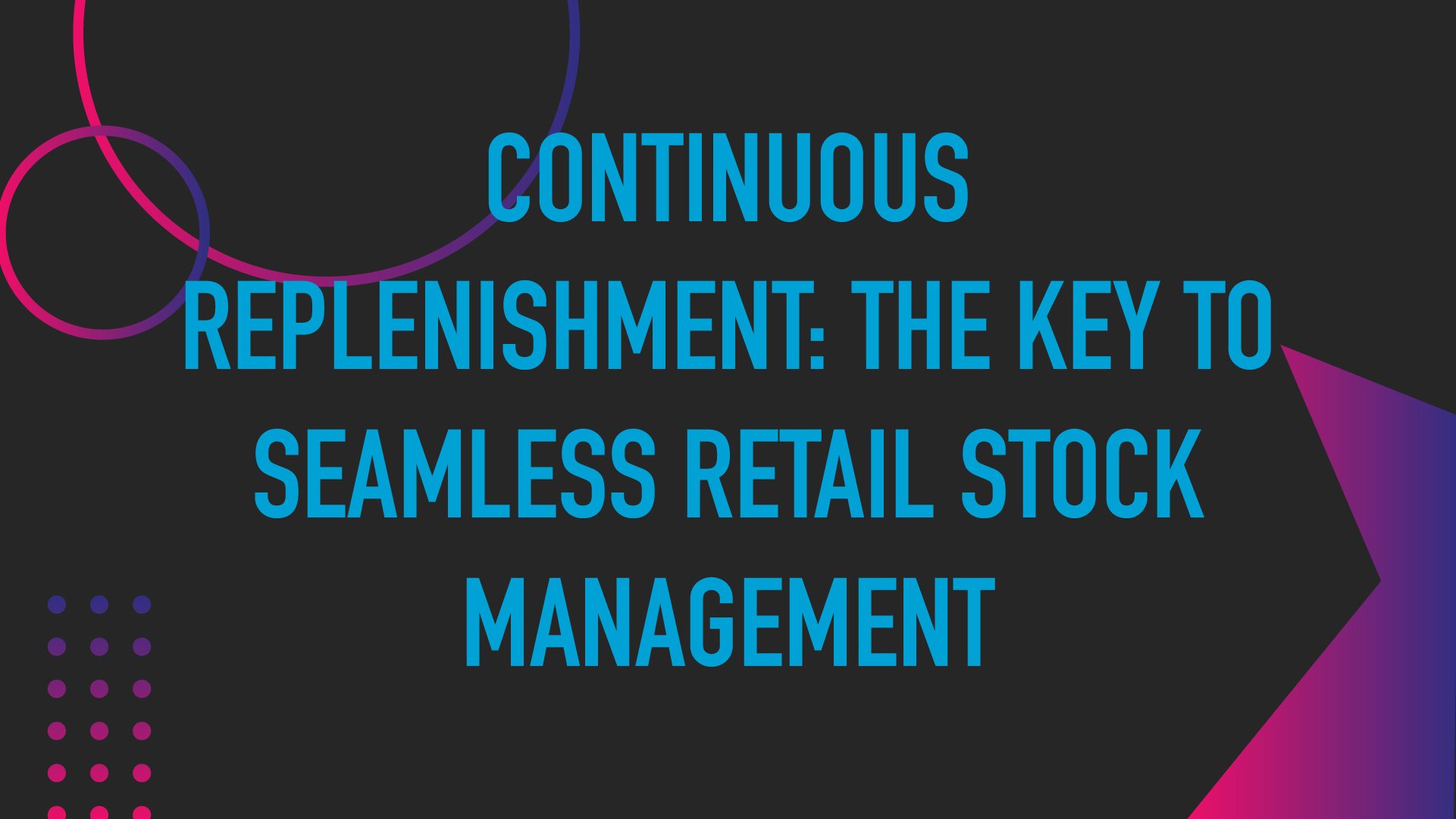The Fascinating History of Modern Retail

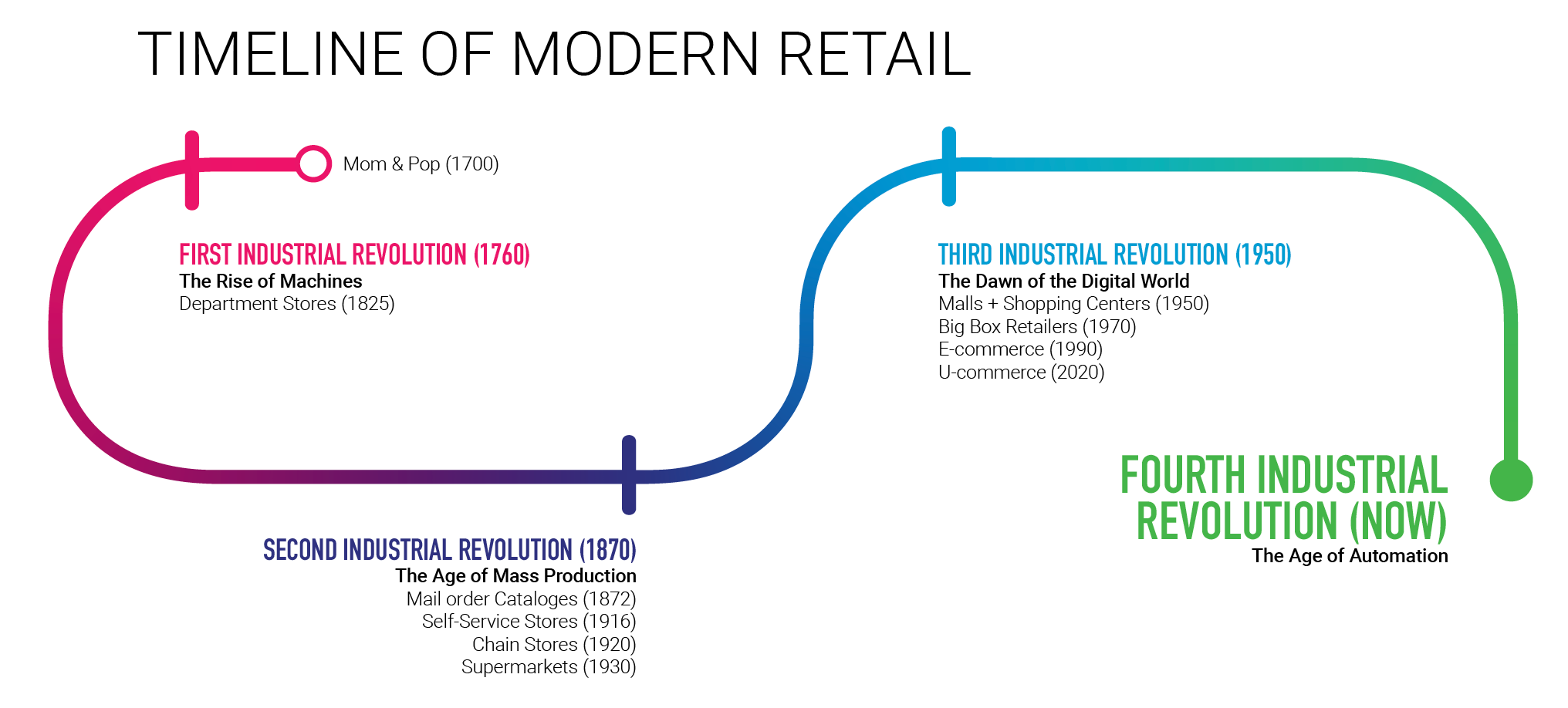
Why should you want to learn about the history of retail stores? For one, history teaches us a lot about the present, and the present state of retail is very complex.
Not long ago (in the grand scheme of history), we had to stroll into small, locally owned brick-and-mortar stores to purchase dry goods and daily necessities. Now (around ten generations later), we can purchase almost anything we want with our finger or voice while we lounge in our pajamas at home and wait for a package to mysteriously arrive at our front door.
Ever since the 1760s, when highly efficient machines began to revolutionize the production of goods and overshadow callused artisans and local farmers, retail has evolved at a dizzying pace. In order to understand this evolution, and given that retail ultimately reacts to what consumers want or need (and the technology they use), it's a good idea to first understand the wider societal contexts retail evolved within.
Historically, the biggest influence on retail's trajectory has been technology. From milling machines to railroads, automobiles to computers, technology has irreversibly shaped our societies, our personal lives, and consequently the way we shop. Because of this strong influence, we've organized retail's timeline by the four industrial revolutions (which conveniently correlate to the "technological revolutions").
Approaching the history of retail stores from this perspective will help us better understand the current state of retail and where it may be headed next.
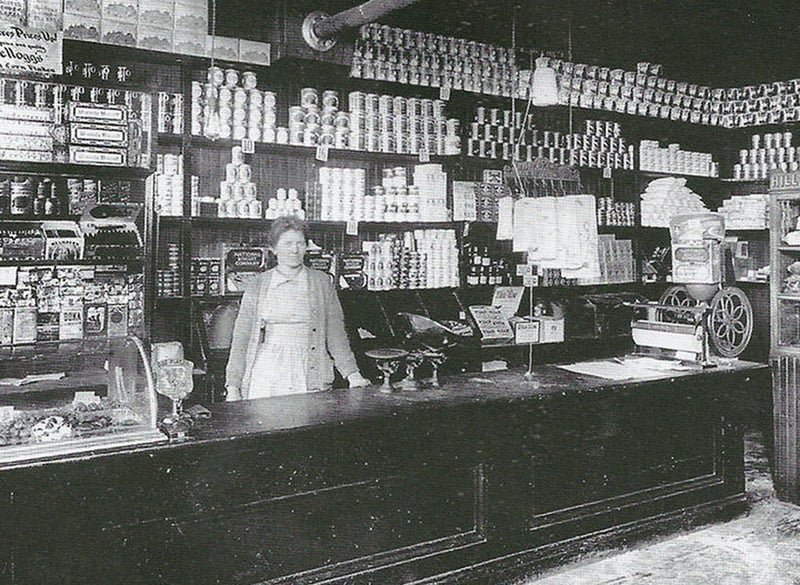
Minnie Daubenberger, store owner in New Jersey; circa 1900 (courtesy of Hudson County Genealogical and Historical Society)
MOM & POP SHOPS: The beginning of Modern Retail
1700
Some of the first retail stores (that resemble stores as we know them today) were small, family-owned operations called "mom-and-pop" shops. From the 1700s on through the early 1900s, these stores acted as community hubs and typically offered products such as dry goods, medicine, and other non-fresh daily necessities. (At the time, fresh produce was not yet a prominent part of retail due to technological/logistical limitations.)
Although many mom-and-pop shops fell victim to chain stores and big-box retailers later on, many withstood the test of time. New York City apparel company Brooks Brothers, for example, was founded in 1818 and still creates clothing to this day. Well-known jewelry retailer Tiffany & Co., founded in 1837, is another mom-and-pop triumph.
Small, family-owned stores may never be as widespread as they were in the 18th and 19th centuries due to current economies of scale, but they still play a crucial role in modern retail. From the hardware store in Pittsburgh that still helps its shoppers fix small repairs to the family-owned Christmas tree business in Palm Springs, the spirit of the mom-and-pop shop lives on.
First industrial revolution ⚙️
The Rise of Machines (1760)
- Machines begin to replace hand-made production at unprecedented levels, allowing for high-volume production that will fuel the new consumer goods industry
- Due to the profitability of machine production, factories begin to dominate the urban landscape, resulting in an abundance of new job opportunities that attract people from rural areas
- The high population density in cities, combined with high-volume production from machine factories, sets the stage for modern retail stores
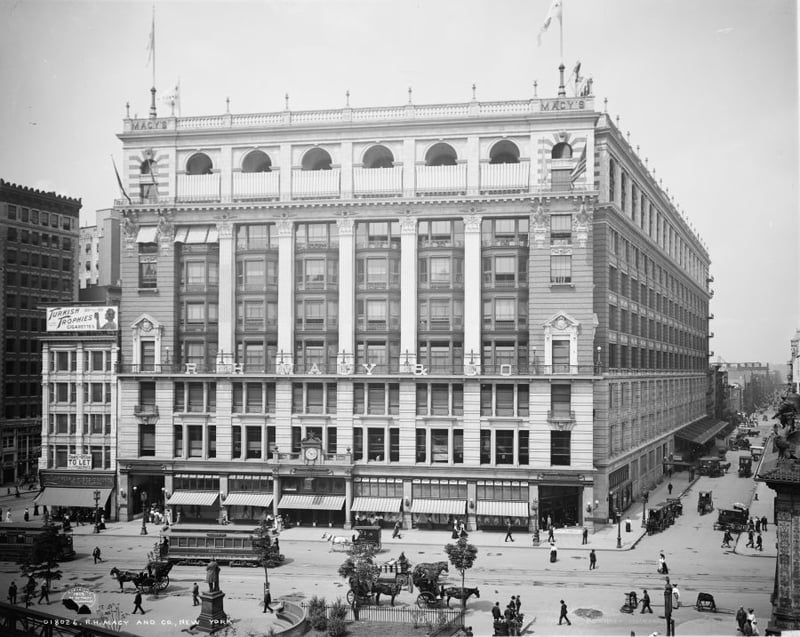
Macy's department store at its new location in Herald Square (Detroit Publishing Co. 1905)
DEPARTMENT STORES
1825
At the turn of the 19th century, Aaron Arnold opens Arnold Constable & Company, a dry goods store in New York City that marks the beginning of the modern department store, in which a wide variety of consumer goods are made available to shoppers in a single store location.
Not long after, in the shopping district of 1852 Chicago, Marshall Field & Company is pushing the limits of what a department store can be. One of the first stores to go all-in on shopper experience, Marshal Field's sets the standard for modern retail. From their revolving credit model to their in-store escalators and interactive displays, Marshal Field's helps transform shopping from a chore into an enjoyable activity.
Six years later, now-iconic department store Macy's sets up shop in the Big Apple, raking in a grand total of $11.06 on their first day of business. However, by thinking creatively about shopper experience, and differentiating themselves with experiences such as in-store Santa Claus during the holiday season, themed exhibits, and illuminated window displays, Macy's quickly becomes a shopping destination.
Department stores began popping up all over the urban landscape. Stores are growing bigger and bigger. And shoppers begin expecting more and more from retailers.
Second Industrial Revolution 🚂
The Age of Mass Production (1870)
- New technology reshapes life as we know it
- The telegraph and radio introduce long-distance communication
- Electricity is fully harnessed, meaning that people stay up later and stores stay open longer
- Railroad expansion accelerates and lengthens the supply chain, allowing manufacturers to ramp up production levels and expand their reach
- Shopper experience becomes more important, opening the door for new types of retail stores that will eventually eclipse mom-and-pops
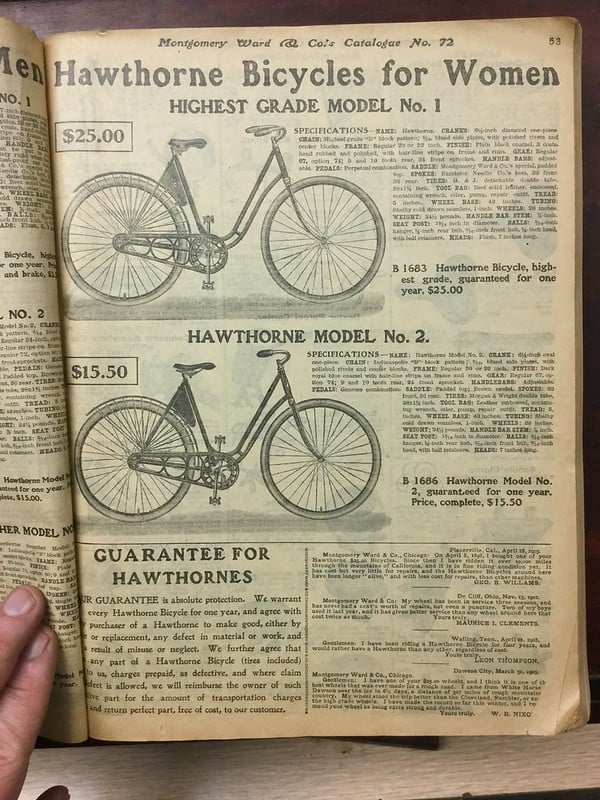
Montgomery Ward & Co. catalog, 1903-1904 (Mike Mozart)
Mail-Order Catalog
1872
Before there was e-commerce, there were mail-order catalogs.
In 1872, Aaron Montgomery Ward gets the crazy idea to sell goods directly to customers instead of through a middleman. Ward cut his teeth as a traveling salesman, and while doing so he noticed that rural retail was lagging far behind its urban counterpart. Many small towns still relied on mom-and-pop shops that had less inventory and higher prices than big-city department stores.
Ward's solution: he opens a department store of his own (Montgomery Ward & Company) and creates a complementary catalog that he mails to customers at no charge. For the first time, rural Americans can order the same products, at the same low price, as urban dwellers.
This was a groundbreaking development in the history of retail that firmly positioned the shopper at the forefront of retail stores' concerns. And little did Ward know, he wasn't just helping rural Americans; he was paving the way for a universally accessible, direct-to-consumer, e-commerce market that would emerge over a century later.

An inside look at the first Piggly Wiggly self-service grocery store in 1918 (Historic-Memphis)
Self-Service Stores
1916
The surging popularity of mail-order catalogs (now adopted by the likes of Sears, JCPenny, and other big players in the department retail space) crystallized the importance of convenience as a differentiator among retailers.
Aided by technological advancements, much of retail's evolution from this point forward centers around providing shoppers with convenient experiences. One of the first manifestations of this emphasis on shopper convenience sprouted along the streets of Memphis, Tennessee.
In 1916, Clarence Saunders opens the first-ever self-service grocery store (or "groceteria"), the mysteriously named Piggly Wiggly. Believe it or not, grocery stores weren't always like they are today. Before Clarence disrupted the scene, shoppers would wholly rely on store employees to find and retrieve products for them, especially in the grocery sector.
Piggly Wiggly, despite the silliness of its name, is a serious step forward in retail's evolution; it introduces unprecedented levels of convenience to shoppers that nearly every retailer will emulate. This upgrade, however, comes at a cost.
By transferring shopping responsibility from the store employee to the customer, in-store execution becomes much more important. Store employees no longer stand between customers and products, meaning that shelves and product must speak for themselves. If product is misplaced or if shelves are empty, shoppers are more likely to direct their business elsewhere.
(Thankfully, retailers and the teams who operate in stores can now use retail execution software to nail all of their in-store projects and activities.)

Kroger storefront, circa 1920 (Cincinnati Museum Center)
Chain Stores
1920
In the middle of the second industrial revolution, there was another type of revolution underway: a cultural one.
World War I has just ended, alcohol is now prohibited, and a strange new genre called "jazz" blares through the ceilings of speakeasies across the United States. Meanwhile, thanks to the new efficiencies of mass production and assembly lines, and relative financial prosperity, automobiles become more and more accessible, which allows cities to spread wider and wider (see where we're going with this?).
Amid the roaring twenties, chain stores (that is, stores with multiple locations) begin to rise. The retailers who catered to customer experience, maximized convenience, and optimized their stores now have the capital to expand their services far beyond a single location.
This a wildly competitive time in retail's history. Retailers are pursuing more and more of the consumer goods market share, and new types of store models are popping up left and right.
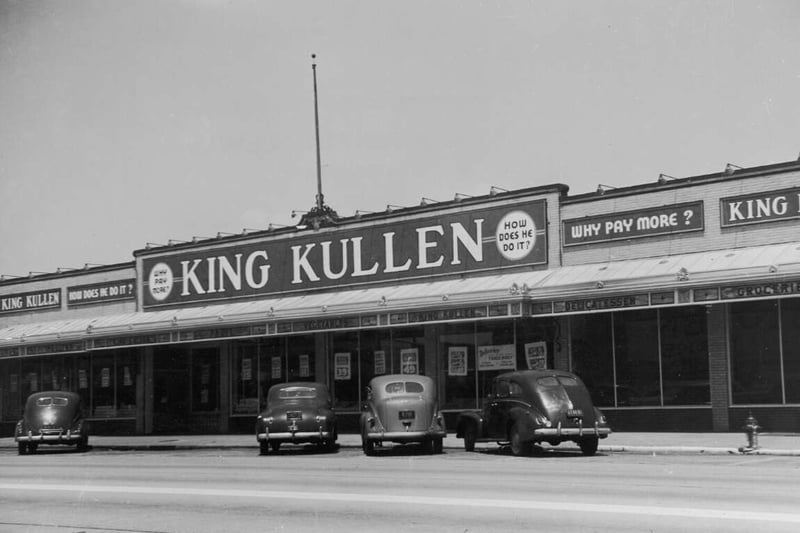
King Kullen supermarket, circa 1940 (R. Gates, Getty Images)
Supermarkets
1930
Michael J. Cullen, an Irish immigrant who worked his way up to a Kroger executive, writes a letter to Kroger's president proposing a radically new type of retail store, one of “monstrous" size and "plenty of parking space" that would be "twenty percent service and eighty percent self-service," a high-volume, low-cost store in low-rent locations with multiple departments and the best prices around.
The letter is ignored (and not by the president, but by the vice president of Kroger who thought it unworthy of the boss's attention). Shortly after, Cullen departs from Kroger and opens his own store on the outskirts of New York City, one that fits all the characteristics scrupulously outlined in his letter, a "price wrecker" centered around convenient shopping that would later be recognized as the first supermarket in American history: King Kullen.
Cullen's new store model is an instant success that other retailers soon emulate: low prices, huge square footage, wide selection of fresh and dry product, plenty of parking for the rapidly growing number of automobiles, everything a shopper needs in one convenient location... this is the new standard for ambitious retailers.
Third Industrial Revolution 🌐
The Dawn of the Digital World (1950)
- In 1947, the first American suburb (Levittown) is erected in Long Island, New York
- Around 1947, the transition from analog and mechanical technology to digital begins with the creation of a simple transistor
- In 1969, the building blocks of the internet emerge from a government program
- In 1970, computers begin making their way into homes (by 1984, 8.2% of all U.S. households own a personal computer)
- In 1989, Tim Berners-Lee creates the World Wide Web, ushering in unprecedented levels of digital communication and connected information
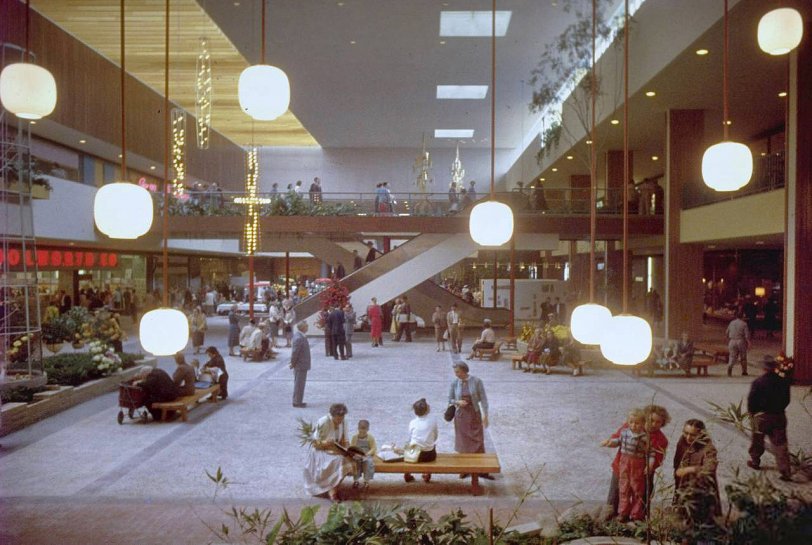
An inside look at Southdale Regional Shopping Center in Edina, MN, 1956, America's first indoor mall (Grey Villet, Life Magazine)
Malls & Shopping Centers
1950
By this point, automobiles have become cheap enough that they are being adopted by the masses. In 1950, nearly eight million vehicles are produced in the United States alone. The surge in automobile ownership, alongside the rapid expansion of suburban living, sets the stage for the new wave of retail stores: shopping centers.
One physical location dedicated wholly to shopping, with various stores clustered around one another (indoors in the case of malls). Instead of walking down the street to shop, more and more Americans begin climbing into cars and driving relatively far distances to satisfy their retail needs.
The first modern, indoor mall opens in Edina, Minnesota, in 1956. Much like the pioneering department stores of the 19th century, customer experience is at the forefront of concern. Malls not only become a fun place to shop but a cultural nucleus for the less densely populated suburbs.

The first Walmart store in Rogers, Arkansas, 1962 (Walmart History Museum)
Big Box Retailers
1970
In 1962, in a little town in Northwest Arkansas, Sam Walton opens the very first Walmart store, a soon-to-be discount supermarket chain that prides itself on everyday low prices. While this is not a new differentiator in retail's history, Walton and other competitors took discount shopping to its ultimate limit.
By 1967, there are 24 Walmart stores raking in $12 million in sales. Three years later, Walmart becomes a publicly traded company and begins their national expansion. Stores get bigger and bigger, but prices stay low.
In 1980, the first Walmart Supercenter opens, combining grocery and general merchandise into one massive indoor location with large parking lots. The new wave of retail is well underway, and it's all about efficiency of scale, convenience, and shopper experience.

Jeff Bezos, circa 1995 (Rex Rystedt/The LIFE Images Collection via Getty Images)
E-Commerce
1990
While retail stores continue to grow bigger and bigger and expand further and further, an unassuming new thing called the internet emerges in the background.
In 1993, Tim Berners-Lee's World Wide Web (a network of digital pages with searchable addresses) is finally released to the public. Anyone with access to a computer and internet can now create their own website and share information digitally with none of the constraints of physical communication. It did not take long for visionary thinkers to take advantage of this mysterious new digital world.
Fueled by the same motivators as their predecessors (namely convenience, affordability, and customer experience), retail-preneurs begin setting up shop not in urban cities, and not in automobile-saturated suburbs either, but online, the most convenient location yet.
One such retail-preneur started an online bookstore from his garage in 1994. Now, he's one of the wealthiest humans in the world, and his bookstore is the largest online retailer too, a testament to the scalability of digital commerce and maturity of the global supply chain.
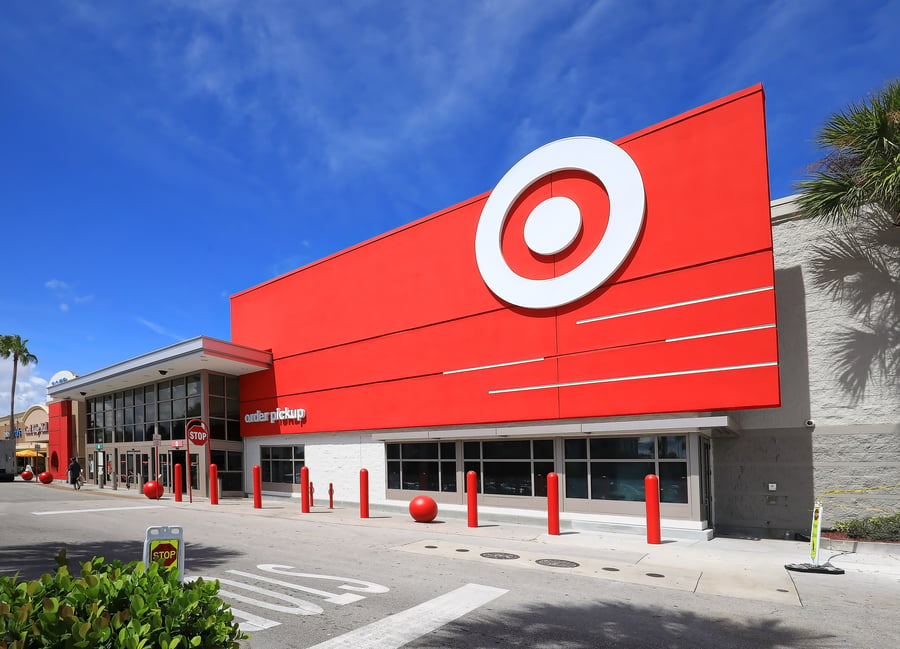
U-Commerce
2020
Once e-commerce begins to take off in the '90s, physical retailers quickly sense the danger and begin adopting online stores of their own, gradually creating the multi-dimensional, "omnichannel" shopping environment we know today. Consumers can now purchase goods from a retailer online or in-store, and they can receive these goods in a variety of convenient ways (traditional self-service, curbside pick-up, BOPIS, home delivery).
The attempt to unify and perfect these channels is known as unified commerce or "u-commerce" for short. Just as our retail predecessors focused on providing shoppers with enjoyable shopping experiences, so too do modern retailers, only now they must do so in both the digital and physical world (no easy feat). It's worth noting that the COVID-19 pandemic accelerated this transition to unified commerce.
Most retailers are using their existing brick-and-mortar stores as fulfillment centers for online orders (Target, for example, fulfills 95% of their digital orders through physical stores), but this is only the beginning of u-commerce. As technology continues to rapidly improve, the divide between the physical world and digital world will continue to shrink until, eventually, the two merge seamlessly into one.
The digital world is no longer exclusive to smartphones and computers, nor is it separate from everyday reality. It's in our watches, our speakers, and our cars, and it's only a matter of time before it's in our heads too (literally).
Fourth Industrial revolution 🤖
The Age of Automation (In Progress)
- Automation has been a factor in every industrial revolution, but it has mostly restrained itself to physical labor (replacing hand-made production with machine production, for example). With the quick development of artificial intelligence and machine learning, however, human civilization is on the cusp of fully automating intelligence-based work too
- ChatGPT, a new AI chatbot created by OpenAI and launched in December of 2022, is the most recent example of AI's promising (yet dystopian) potential
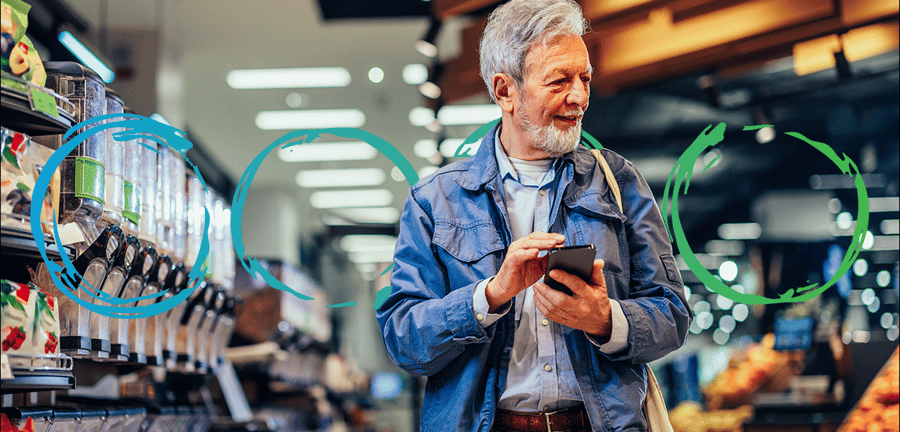
The TakeAway
Human life has evolved so fast in the past two decades due to technological advancement that the past seems almost irrelevant to us, as if things were so different back then that we can't possibly learn from our analog predecessors, especially in an industry like retail that has covered so much ground in so little time. But a quick trip down memory aisle reminds us that retail hasn't really changed all that much.
Sure, it looks a lot different and operates at a much higher level, but it runs on the same motivators as it always has. In other words, both Aaron Arnold in 1852 and Jeff Bezos in 2022 care about the same thing, providing consumers with:
- Convenience
- Wide selection
- Enjoyable shopping experiences
- Low prices
That's pretty much it. The only difference is that now retailers must achieve these four things in a phygital world of smartphones, artificial intelligence, robotics, and all the other unique attributes of our current place in time. History will look kindly upon the retailers who stay true to the fundamentals of retail, regardless of the current technology or trend.
If the "next big thing" in retail (looking at you, metaverse/virtual reality) is not convenient and enjoyable for the shopper, it is not the next big thing.
Where Does Movista Fit in the Evolution of Retail?
In the hands of frontline workers.
On the computers of retail managers.
Our retail execution software is the grease that keeps the gears of retail running smoothly, the solution that today's retail teams need to coordinate with each other, collaborate on projects, complete tasks, track performance, and measure outcomes.
One unified solution for all retail execution.
Simply put, Movista is the digital tool that today's retail workers must have to excel in an increasingly digital world.
featured content
featured content

The Importance of On-Shelf Availability in Retail: Why Keeping Items Stocked is Critical for Competitiveness in 2026
Learn why on-shelf availability is critical in today's retail store environment
